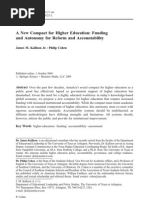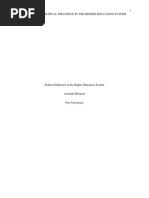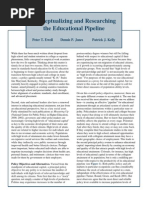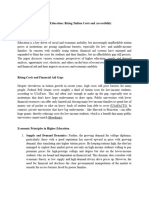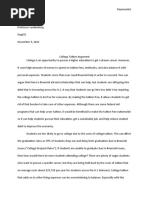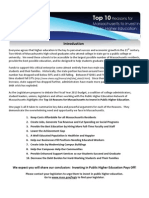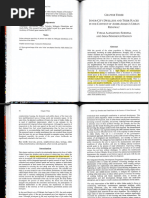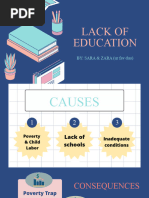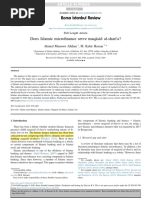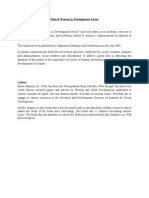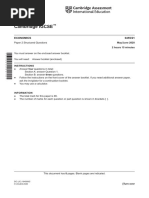Missed Opportunity For Tuition-Free College Education: Explaining Fee Increases at California State University
Missed Opportunity For Tuition-Free College Education: Explaining Fee Increases at California State University
Uploaded by
egv486Copyright:
Available Formats
Missed Opportunity For Tuition-Free College Education: Explaining Fee Increases at California State University
Missed Opportunity For Tuition-Free College Education: Explaining Fee Increases at California State University
Uploaded by
egv486Original Title
Copyright
Available Formats
Share this document
Did you find this document useful?
Is this content inappropriate?
Copyright:
Available Formats
Missed Opportunity For Tuition-Free College Education: Explaining Fee Increases at California State University
Missed Opportunity For Tuition-Free College Education: Explaining Fee Increases at California State University
Uploaded by
egv486Copyright:
Available Formats
PolicyMatters Journal
Missed Opportunity for Tuition-free College Education:
Explaining Fee Increases at California State University
Christina Kersey
Edited by Chelsea Kelleher, Olivia van Nieuwenhuizen, Shirin Panahandeh, and J. Oliver Schak
The Master Plan for Higher Education, passed in California in 1960, formalized the role for the California State University and committed to providing free college tuition for legal residents of California. Since then, the system for funding higher education in the state has slowly moved away from this commitment. This article explores possible reasons for that departure, including changing levels of public support, economic recessions, and financial aid policies. Analysis of primary source documents from the California Postsecondary Education Commission and interviews with higher education policy experts support this examination of each possible cause. This article finds no specific factor to be responsible, rather a convergence of factors and events that have led to the current reliance on student fees by the CSU system. INTRODUCTION
With the passage of Proposition 30 on November 6, 2012, the financial distress of the California State University (CSU) may be somewhat ameliorated. Proposition 30 stabilized the budget by generating additional revenue with a one quarter cent increase on the states sales tax, as well as an increase in personal income tax rates for those making more than $250,000 per year. Proposition 30 also halted a mid-year trigger cut of $250 million that was going to be imposed on the CSU. However, the CSU system still faces significant financial difficulties, as the problems with fees go back much further, and are much deeper, than the annual increases we have seen in response to the current economic recession. The California Master Plan for Higher Education, passed in 1960, formalized the three-tiered structure in place today community colleges, the California State University, and the University of Californiawith each system serving a different purpose in higher education. The Master Plan also expressed clearly the intention that college tuition in California should be free for legal residents. Students were responsible for paying fees that covered the costs of expenses excluding instructional minutes, such as lab equipment, health centers, and the student newspaper. As of January 2011, the CSU now refers to the portion of college education paid by students as tuition fees. The shift in terminology from fees to tuition fees may seem minor, but it underscores a more significant shift in the perception of the role of the state to fund higher education. If we understand how we arrived at this point, www.policymattersjournal.org we may have a better understanding of what is necessary to change this trend, assuming that Californians desire a change.
State higher education funding
Higher education has been competing for scarce resources with K-12 education, corrections, and the rising costs of Medicaid. Data from the California Postsecondary Education Commission (CPEC) show that state funding for higher education as a percentage of the General Fund (GF) budget has indeed decreased over time from a high of 17.7 percent in 1972-73 to between 11 and 12 percent for the majority of the last decade. Interestingly, the K-12 education budget hovered near 40 percent of the GF budget long before Proposition 98 passed (beginning around the late 1970s to early 1980s), making it less clear that higher education has been in competition with K-12 education. Similarly, it is argued that states have felt a budget squeeze from Medicaid since the 1980s, but it seems more likely that higher education has been fighting for scarce resources with corrections and that the higher education budget has declined as the corrections budget has increased. The data also show that for the most part, despite fluctuations in percentages, each sector saw an increase in its budget over the years, as shown in Figure 1. During periods of less fiscal prosperity, the budgets did decrease slightly, but an examination of the corrections budget demonstrates the dramatic effect that an increase of a few percentage points can have over the Fall 2012
PolicyMatters Journal
HIGHER EDUCATION
Figure 1. Expense Categories as Percentages of the General Fund Budget1
course of multiple years. The budget alone does not tell the whole story, since we know that the population has changed dramatically and the number of students being served in both K-12 and higher education surpassed early estimates. Growing Reliance on Revenue from Student Fees In the 1960s and 1970s, fee revenue accounted for between approximately 5 and 9 percent of the primary revenue funding sources. By the early 1990s, another recession period, fee revenue made up over 20 percent and in 2008-09 it accounted for over 39 percent. The data indicate that fee increases are particularly susceptible to decreases in the CSU budget, typically during economic downturns. Figure 2. CSU Resident Student Fee Revenue as Percentage of CSU Budget2
Fee revenue has become a critical source of funding for the CSU system, especially in the last two decades. This growing reliance on student fee revenue implies that students and their families have indeed begun to pay a greater share of the cost of a college education. Public Still Supportive of Higher Education but Wants More Accountability Some authors have argued that there has been a shift in ideology causing the public to be less inclined to support higher education funding. This shift may have begun decades ago, as an early CPEC document explains: To some extent during the 1970s, public education was caught in societys general skepticism about the integrity of its political institutions.3 However, national polls indicated the public still considered it a high priority, though there was concern about the management of the system and a need for accountability. More recently, a 2010 poll conducted by the Public Policy Institute of California (PPIC) found that 86 percent of Californians believe a college education is very important and 74 percent of California residents believe higher education is underfunded. Furthermore, a majority favors spending more on higher education, even if it means reducing funding for other programs. The institutions themselves have recognized that as demographic and financial situations have changed, there is an increased need to determine how best to use their resources. The CSU Provost and Vice President for Academic Affairs recently asked, Can our universities work seriously with K-12 on college readiness, so that we can use differently the more than $50 million that we now spend on remediation just in the CSU?4 The recent request for a salary freeze for top paying
www.policymattersjournal.org
Fall 2012
Missed Opportunity for Tuition-free College Education
positions in response to several incoming CSU presidents receiving salaries 10 percent above their predecessors is an example of the disconnect the public feels between the public institutions and how the institutions have shown their accountability with the use of discretionary funds. Leaders Think Students Should Pay More In the 1970s, numerous publications began to ask questions such as Who pays for higher education? Who benefits? Who should pay? And how much should they pay? This suggests a shift in the view of higher education from primarily a public good (a view shared in the Master Plan) to more of a private good. If the individual is a greater beneficiary, then the individual should pay a greater share of the cost. Despite these questions, during this time, the reports and recommendations for fee policies in California continued to reaffirm the intention of the Master Plan that the state should bear the primary responsibility for funding higher education. In 1972, it was suggested that with costs rising for higher education (enrollment had doubled and costs had experienced a fourfold increase) and other state programs, it was time to re-examine the tuition-free policy to determine if it was still appropriate and feasible.5 This suggests policymakers were adopting a perspective of financial necessity, not shifting in ideology. It was recommended that resident students with the ability to pay at UC and CSU should contribute towards the cost of their instruction, but the amount should be kept as low as possible and not exceed that of comparable universities. Despite this recommendation, the CSU did not openly collect or use student fees for the purpose of instruction (the definition of tuition according to the Master Plan) until a much later date. In 1992, an option was proposed of setting fees to a certain percentage of the total cost of instruction (for example, fees at the CSU would be 25 percent of the total average cost of instruction). The report noted that this would be a departure from the history of providing tuition-free education and keeping fees as low as possible.6 A 1993 report noted that the question of how much of the costs of higher education should be borne by the students has still not been addressed systematicallythe only answer to date (in terms of present practice in setting fees) being ever more than before, with practice far exceeding State policy of moderation in fee increases.7 The report stated that per the Master Plan, fees were to be charged for costs not directly related to instruction, but the fees charged now clearly exceeded those costs. A 2002 fee policy Commission still recommended that the state bear the primary responsibility for the cost of higher education, that resident fee increases should be gradual, moderate, and predictable (as possible), and that indicators, such as the percentage change in per capita personal income, www.policymattersjournal.org should be used to help determine fees to maintain gradual and moderate increases.8 Although there have been many attempts to redefine the Master Plan, it has not happened yet. Throughout this evolving discussion, some have described student fees as too high while others believe they are too low, making it difficult to determine an appropriate fee level.
Fee policies discussed or adopted after recessions
Long-term fee policies may be the result of reactions to fee increases, usually after recessions. The timing of fee policy committees or commissions coincides with years following recession periods in the 1980s, 1990s, and 2000s. This suggests that when times are better and funding is more stable, determining an appropriate fee policy is less of a priority. A 1984 report noted that the recession was clearly a major factor in the rapid rise in student fees, since other states had similarly seen large increases in student fees.9 The report stated the recent increases in fees at both institutions have stemmed less from any basic change in State policy toward student fees than from severe State budget shortages caused by the recent recession, compounded by tax-cutting measures such as Proposition 13. In 1996, the existing student fee policy in place from 1985-1996 expired. In 2002, after a period of economic stability followed by another decline, the legislature once again directed CPEC to develop long-term fee policy recommendations, given the lack of a statutory fee policy and the Sates deteriorating fiscal situation.10 The intention to create a long-term fee policy after fee increases also suggests that policymakers are aware of the hardships caused by dramatic fee increases, and implies a genuine desire to maintain fees that are as low as possible. It also suggests fees increases are driven by financial necessity. Reactions to Recessions Exacerbated by Optimistic Budgeting and Assumptions Since fees and fee policies appear to be so closely tied to the budget, the State budget itselfand the amount of funding the State issues to the CSUis clearly a factor. It has been argued that colleges and universities do disproportionately well during financially good fiscal years, but are disproportionately cut during periods of bad economic times.11 Some claim this is because of the institutions ability to raise additional revenue through fee increases, an option other state supported programs do not have. While tax structure and limited term politicians may be part of the problem (and both of these characteristics could be attributed to Californias budget Fall 2012
PolicyMatters Journal
HIGHER EDUCATION
problems), another issue is not an economic force, but a behavioral force, or the tendency to assume that the future will be like the immediate past.12 The state tends to take an optimistic approach to expected revenues, as though they believe that when times are good, they will always be good. This also encourages over-committing resources. Robert Harris, long-time employee of the Department of Finance, made a similar observation, describing a need for a stable input mechanism to project budgets, though Californias tax flow structure remains very volatile. There is no capacity to know what it will be, so there is a tendency to assume greater input to balance the budget and implement programs. Unfortunately, you can only divide a dollar so many ways. And when that dollar is really only seventy-five cents you have even more problems.13 Better economic times did not seem to require or present the same need for fee policies compared to periods of recessions. The financial conditions that led to dramatic fee increases were followed by requests for long-term fee policies. The need for more revenue was a greater priority than following the established rules for keeping fee increases gradual.
student fees for the CSU to offset a portion of the reduction in State General Fund support.18 This appears to be the first open use of fee revenue to supplant State funding for the cost of instruction. These higher fees have forced the State and its public systems of higher education to abandon at least in practicetheir long-held principle of tuitionfree education, since student fees are now being used to support instruction and instructionally-related activities that were previously agreed to be the responsibility of the government.19 In a 2006 CPEC report, the Commission stated the basic tenets of the Master Plan regarding affordability have been eclipsed by the need to maintain access and educational quality in the face of declining state support.20 What these reports show is that over the years as the conversation of a long-term fee policy as been discussed, the intentions of the Master Plan remain relevant. There is large support for a system that keeps college affordable, with the state paying a larger share of the cost than students and families. However, despite the desire to keep fees moderate and predictable, over time, the reliance on fee revenue has become greater, due to the decisions of policymakers and the current economic recession.
Fee increases should be gradual, moderate, and predictable
Some have argued the changes that have occurred have been incremental over time. Certainly the policy recommendations attempt to protect students and their families by making increases gradual, moderate, and predictable. Unfortunately, economic realities often undermine good intentions during periods of recession. In 1978, CPEC released a five-year plan update, noting that Proposition 13 had caused a fiscal crisis, and fee increases became a topic once again. Although concerned about the effects of fee increases, the commission noted that increased student charges must be considered as one of several possible source of additional funding for the long-range financing of postsecondary education.14 The 1984 Fee Policy Committee was partly the result of the Legislatures concern of the lack of explicit policies that had allowed CSU fees to increase so dramatically in a few short years, and also the impact this would have on access to higher education.15 Part of the solution to this problem was the recommendation that fees should be fixed at least ten months in advance and increases or decreases should not exceed 10 percent from the prior year.16 The policy adopted was based on these recommendations. Senate Bill 195 stated fee increases should be gradual and moderate.17 The early 1990s marked another fiscal crisis and SB 1972 allowed the institutions to increase fees above the statutory cap of 10 percent, which meant a 40 percent increase in www.policymattersjournal.org
Financial aid policies may have opened a door for FEE increases
In 1994, CSU Chancellor Barry Munitz proposed an additional fee hike and included a provision that one-third of all new student fee income be used to ensure continual access of low-income students.21 It is not clear how this percentage was derived, but it has been used consistently. It has been suggested that taking care of the neediest students with such policies makes it easier to raise fees. Called discounting, this practice has actually become one of the factors exerting upward pressure on tuition levels.22 Access is one of the fundamental cornerstones of the CSU system. One of the motivations for keeping student fees low is to ensure universal access. Financial aid has become a major component for ensuring that students from lowincome families are able to attain their college goals. With each increase in fees, or decrease in state funding, maintaining adequate financial aid became a higher priority, and often, recommendations for fee policies included additional recommendations for explicit financial aid policies. Boyd Horne, a former financial administrator for CSU, agreed with this theory, stating, Federal and state financial aid is at play because the fee amount determines the dollar amount students are eligible for, making it a back door way to get additional aid.23 The policy itself did not cause fee increases, but it was a part of the rationale for why increases could be implemented with minimal damage. Former president of CSU, Dr. Donald Gerth agreed, believing that the policy gave Fall 2012
Missed Opportunity for Tuition-free College Education
a license to increase fees based on the idea that everyone that needed help would receive it.24 Student fees have made up a larger share of the CSU revenue since the early 1990s. Until 1992-93, there were only two years in which the fees exceed 15 percent of the total revenues1983-84 and 1991-92otherwise, fee revenue made up less than 14 percent.25 Since 1992-93, there was only one year2000-01in which fees made up less than 17 percent of total revenues. It is clear that the CSU is committed to maintaining access to its universities by ensuring financial aid for the neediest students, having implemented a policy dedicating a percentage of fee revenues to financial aid. The fact that fee revenues have made up a larger share of the CSU budget since the time that policy was passed indicates that this is a plausible argument. is what has gotten us here, and under the current circumstances original intentions seem unrealistic now. Despite decades of research and analysis to determine an appropriate fee policy for the CSU, such a policy or explicit methodology still does not exist. Developing a rational fee policy is no easy task, and poor financial times mean few options for the CSU, leaving fee increases as the most obvious option for additional revenue. Although the passage of Proposition 30 means less of a reduction to the CSU funding, this proposition, like many of the solutions proposed in the past, is not a permanent solution. Harsh economic realities have for decades continued to slowly erode the idea of tuition-free education. A budget is a representation of an agencys priorities, and our state and universities reveal to the public what they value most through these documents. While California may still desire tuition-free education, what is the feasibility of such a desire? It is time to have a different conversation about higher education funding that looks at a policy based on these economic realities, instead of the philosophy that we have clung to but can no longer maintain.
Conclusion
There are a number of explanations for why the state appears to have moved away from the Master Plan ideals. Ultimately many of these explanations for how we have arrived to our current situation are intertwined. Perhaps the lack of planning
Christina Kersey graduated from California State University, Sacramento with a Master of Public Policy and Administration in May 2012. She currently works in the Categorical Allocations and Management Assistance unit at the California Department of Education in Sacramento.
Endnotes
[1] California Postsecondary Education Commission, http://www.cpec.ca.gov/ FiscalData/ FeesAndFunding.asp; Higher Education includes: Hastings College of Law, University of California, California State University, GF portion of Community College budget, California Student Aid Commission; 200809 and 200910 information is estimated; 201011 is based on the governors proposed budget. [2] Ibid. Resident student fees as a percent of fee revenues and general purpose funds combined; general purpose funds include state General Funds and local property tax revenue; does not include Federal American Recovery and Reinvestment Act funding in fiscal year 2008-09 or 2010-11. [3] California Postsecondary Education Commission, Issues in Planning for the Eighties, 1980, accessed at http://www.cpec.ca.gov/Compl eteReports/1980Reports/80-11.pdf/. [4] Harry Hellenbrand, The California Master Plan: From Icon to Ipad, Message from the Provost, accessed at http://www.csun.edu/ academic.affairs/ca_master_plan.pdf.
[5] California Postsecondary Education Commission, The California Master Plan for Higher Education in the Seventies and Beyond, 1972, accessed at www.cpec.ca.gov/completerep orts/1972reports/72-6.pdf. [6] California Postsecondary Education Commission, Analyses of Options and Alternatives for California Higher Education, 1992, accessed at www.cpec.ca.gov/CompleteRep orts/1992Reports/92-07.pdf. [7] California Postsecondary Education Commission, The Master Plan, Then and Now: Policies of the 19601975 Master Plan for Higher Education in Light of 1993 Realities, 1993, accessed at www.cpec.ca.gov/CompleteReports/ 1993Reports/93-06.pdf. [8] California Postsecondary Education Commission, Recommendations for a LongTerm Resident Student Fee Policy Framework for Students Enrolled at Californias Public Universities, 2002, accessed at www.cpec.ca.gov/ completereports/2002reports/02-12.pdf. [9] California Postsecondary Education Commission, Directors Report: California Higher Education, 19731983, 1984, accessed at www.cpec.ca.gov/CompleteReports/1984Repor ts/84-12.pdf.
[10] California Postsecondary Education Commission, Recommendations for a LongTerm Resident Student Fee Policy Framework for Students Enrolled at Californias Public Universities, 2002. [11] Hovey, H. State Spending for Higher Education in the Next Decade: The Battle to Sustain Current Support, National Center for Public Policy and Higher Education, 1999. [12] Ibid. [13] Interview with author: Robert Harris (retired), long-time employee at the Department of Finance, March 6, 2012. [14] California Postsecondary Education Commission, Planning for Postsecondary Education in California: A Five-Year Plan Update 1979, 1978, accessed at www.cpec.ca.gov/Compl eteReports/1978Reports/78-18.pdf. [15] Fee Policy Committee, Principles for LongTerm Student Fee Policy, 1984, accessed at www. cpec.ca.g ov/CompleteReports/1984Repor ts/84-40.pdf. [16] Ibid. [17] California Postsecondary Education
www.policymattersjournal.org
Fall 2012
PolicyMatters Journal
HIGHER EDUCATION
Commission, Financing Postsecondary Education in California: 1985-2000. 1985, accessed at www. cpec.ca.gov/CompleteReports/1985Repor ts/85-17.pdf. [18] California Postsecondary Education Commission, Appropriations in the 1992-93 State Budget for Higher Education, 1992, accessed at www.cpec.ca.gov/CompleteReports/1992Repor ts/92-27.pdf. [19] California Postsecondary Education Commission, Restabilizing Higher Education, 1993, accessed at www.cpec.ca.gov/CompleteRep
orts/1993Reports/93-23.pdf. [20] California Postsecondary Education Commission, Resident Undergraduate Student FeesIssues and Options, 2006, accessed at www.cpec.ca.gov/completereports/2006repor ts/06-04.pdf. [21] Gerth, D. R., The Peoples University: A History of the California State University. Berkeley Public Policy Press, 2010. [22] Gumport, P., Iannozzi, M., Shaman, S., & Zemsky, R., The United States Country Report: Trends in Higher Education from Massification
to Post-Massification, National Center for Postsecondary Improvement, Stanford University, 1997. [23] Interview with author: Boyd Horne, a former financial administrator for CSU, March 5, 2012. [24] Interview with author: Dr. Donald Gerth, retired, president of the CSU, Sacramento from 1984-2003, March 9, 2012. [25] California Postsecondary Education Commission, http://www.cpec.ca.gov/ FiscalData/FeesAndFunding.asp.
www.policymattersjournal.org
Fall 2012
10
You might also like
- BANAK BAngus Project ProposalDocument7 pagesBANAK BAngus Project Proposalpatmea71% (7)
- Taxation As A Major Source of Govt. FundingDocument47 pagesTaxation As A Major Source of Govt. FundingPriyali Rai50% (2)
- Why Public Higher Education Should Be Free: How to Decrease Cost and Increase Quality at American UniversitiesFrom EverandWhy Public Higher Education Should Be Free: How to Decrease Cost and Increase Quality at American UniversitiesRating: 3 out of 5 stars3/5 (1)
- Higher EducationDocument13 pagesHigher EducationYaw LamNo ratings yet
- How Much Ivory Does This Tower Need? What We Spend On, and Get From, Higher Education, Cato Policy Analysis No. 686Document24 pagesHow Much Ivory Does This Tower Need? What We Spend On, and Get From, Higher Education, Cato Policy Analysis No. 686Cato InstituteNo ratings yet
- Top 10 Higher Education State Policy Issues For 2012: American Association of State Colleges and UniversitiesDocument6 pagesTop 10 Higher Education State Policy Issues For 2012: American Association of State Colleges and Universitiesapi-143403667No ratings yet
- CUCFA To Yudof Tuition HikeDocument4 pagesCUCFA To Yudof Tuition HikeChris NewfieldNo ratings yet
- PeerreviewDocument6 pagesPeerreviewapi-285096156No ratings yet
- Financing Schools: Analysis and RecommendationsDocument20 pagesFinancing Schools: Analysis and RecommendationsAmjad IbrahimNo ratings yet
- Republican Priorities For Reauthorizing The Higher Education ActDocument11 pagesRepublican Priorities For Reauthorizing The Higher Education ActsajuhereNo ratings yet
- Doyle, W. R. (2020) - Throwing Out The "Recession Playbook" For Higher EducationDocument10 pagesDoyle, W. R. (2020) - Throwing Out The "Recession Playbook" For Higher Educationreyna.xo21No ratings yet
- Deliberation Final Draft 1Document20 pagesDeliberation Final Draft 1api-548506463No ratings yet
- Companion PieceDocument1 pageCompanion Pieceapi-272743675No ratings yet
- Description: Tags: GarlandDocument4 pagesDescription: Tags: Garlandanon-8324No ratings yet
- Estimating The Effect of Student Aid On College Enrollment22Document31 pagesEstimating The Effect of Student Aid On College Enrollment22cdeimoyNo ratings yet
- Is College Education Worth The CostDocument6 pagesIs College Education Worth The Costeson8No ratings yet
- Position PaperDocument8 pagesPosition Paperapi-673819921No ratings yet
- Burden of Higher Education in Recent TimeDocument3 pagesBurden of Higher Education in Recent Timeahmad hashamNo ratings yet
- Sjung LitreviewfinaldraftDocument8 pagesSjung Litreviewfinaldraftapi-264600919No ratings yet
- Literature ReviewDocument6 pagesLiterature Reviewapi-508146273No ratings yet
- Description: Tags: FifieldDocument5 pagesDescription: Tags: Fifieldanon-130747No ratings yet
- A New Approach For Curbing College Tuition InflationDocument16 pagesA New Approach For Curbing College Tuition InflationManhattan InstituteNo ratings yet
- Fighting Back Against Rising Tuition 1Document7 pagesFighting Back Against Rising Tuition 1api-345124344No ratings yet
- Unit 6 PaperDocument7 pagesUnit 6 Paperapi-310891073No ratings yet
- Owen Mockabee - Literature ReviewDocument7 pagesOwen Mockabee - Literature Reviewapi-609373492No ratings yet
- 2009 Summer Attainment ForumDocument6 pages2009 Summer Attainment ForumJohn O. HarneyNo ratings yet
- 2012 Nov CFE LTR Re 2013-14 Budget FinalDocument3 pages2012 Nov CFE LTR Re 2013-14 Budget FinalCSMNo ratings yet
- 2007 09 Mar Com PlanDocument21 pages2007 09 Mar Com Planapi-230084067No ratings yet
- Online PieceDocument5 pagesOnline Pieceapi-272573140No ratings yet
- Making College More AffordableDocument6 pagesMaking College More AffordableCenter for American ProgressNo ratings yet
- University FundingDocument16 pagesUniversity Fundingapi-450356724No ratings yet
- SQE ResponseDocument2 pagesSQE ResponseCPMustangNewsNo ratings yet
- Trump Higher Education ActDocument5 pagesTrump Higher Education ActErin LaviolaNo ratings yet
- Draft On Community Problem 2Document9 pagesDraft On Community Problem 2api-385808802No ratings yet
- Conceptualizing and Researching The Educational Pipeline: Peter T. Ewell Dennis P. Jones Patrick J. KellyDocument8 pagesConceptualizing and Researching The Educational Pipeline: Peter T. Ewell Dennis P. Jones Patrick J. Kellymetasoniko2014No ratings yet
- Why Students Should Oppose Tuition Hikes and Ask For Free EducationDocument4 pagesWhy Students Should Oppose Tuition Hikes and Ask For Free EducationsylogluNo ratings yet
- Commentary: Carrots & SticksDocument28 pagesCommentary: Carrots & SticksbvenkatachalamNo ratings yet
- Pros and Cons of Budgets CutDocument10 pagesPros and Cons of Budgets Cutclaroscuro17No ratings yet
- M2 - Summary of Reading - Questions and AnswersDocument3 pagesM2 - Summary of Reading - Questions and AnswersSyamsul Bahri HsNo ratings yet
- Paper 3 - EducationDocument3 pagesPaper 3 - Educationduryad32No ratings yet
- Why Students Should Oppose Tuition Hikes and Ask For Free EducationDocument4 pagesWhy Students Should Oppose Tuition Hikes and Ask For Free EducationsylogluNo ratings yet
- SUNY Faculty On Budget CutsDocument4 pagesSUNY Faculty On Budget CutsCeleste KatzNo ratings yet
- For Decades Free College 2014Document3 pagesFor Decades Free College 2014notevaleNo ratings yet
- College Tuition ArgumentDocument10 pagesCollege Tuition Argumentapi-583497657No ratings yet
- Issue BriefDocument8 pagesIssue Briefapi-742591251No ratings yet
- Americans College PromiseDocument8 pagesAmericans College Promiseapi-430738231No ratings yet
- ArticleDocument6 pagesArticleapi-264328251No ratings yet
- Position Argument or ProposalDocument5 pagesPosition Argument or Proposalapi-253026182No ratings yet
- Hesa 772 Research Paper BittnerDocument14 pagesHesa 772 Research Paper Bittnerapi-650169045No ratings yet
- Limited Means, Limited Options: College Remains Unaffordable For Many AmericansDocument20 pagesLimited Means, Limited Options: College Remains Unaffordable For Many Americansnailuj9614No ratings yet
- Perfostructural Strength, Weather-Tightness, Acoustic Insulation, Fire-Resistance Rmance Funding AASCU June2011Document12 pagesPerfostructural Strength, Weather-Tightness, Acoustic Insulation, Fire-Resistance Rmance Funding AASCU June2011Rebecca SmithNo ratings yet
- CCPA - Eliminating Tuition and Compulsory Fees For Post-Secondary EducationDocument7 pagesCCPA - Eliminating Tuition and Compulsory Fees For Post-Secondary EducationRBeaudryCCLENo ratings yet
- Opinion Piece FinalDocument4 pagesOpinion Piece Finalapi-232063122No ratings yet
- 03-10-08 CSM-States Balk at Higher-Ed Mandate by Stacy TeichDocument2 pages03-10-08 CSM-States Balk at Higher-Ed Mandate by Stacy TeichMark WelkieNo ratings yet
- Pearson Blue Skies - UK 2012 - 10 - John Holmwood PDFDocument3 pagesPearson Blue Skies - UK 2012 - 10 - John Holmwood PDFMichaelGeorgeBroadNo ratings yet
- Testimony of Richard VedderDocument13 pagesTestimony of Richard VedderM MaliNo ratings yet
- Making College More Affordable For New Yorkers Who Need The Most SupportDocument17 pagesMaking College More Affordable For New Yorkers Who Need The Most SupportCommunity Service Society of New YorkNo ratings yet
- GSA AssignmentDocument16 pagesGSA AssignmentDavid HuangNo ratings yet
- RI NewIdeasForFreeCollege Report 201912Document39 pagesRI NewIdeasForFreeCollege Report 201912batwormyNo ratings yet
- Top 10 Reasons For MA To Invest in Public Higher EDDocument11 pagesTop 10 Reasons For MA To Invest in Public Higher EDMatt VachonNo ratings yet
- Unprofitable Schooling: Examining the Causes of, and Fixes for, America's Broken Ivory TowerFrom EverandUnprofitable Schooling: Examining the Causes of, and Fixes for, America's Broken Ivory TowerNo ratings yet
- AcknowledgementsDocument26 pagesAcknowledgementsbezawit leulNo ratings yet
- Ebook PDF Understanding Social Welfare A Search For Social Justice 9th Edition PDFDocument42 pagesEbook PDF Understanding Social Welfare A Search For Social Justice 9th Edition PDFquintin.lane537100% (48)
- Letter To WBG GovernorsDocument3 pagesLetter To WBG GovernorsGonzalo Jose Silvestre Quiroga SoriaNo ratings yet
- Do Corrupt Gov Receive Less Foreign Aid - Alesina - Weder - 1999Document14 pagesDo Corrupt Gov Receive Less Foreign Aid - Alesina - Weder - 1999Adha MontpelierinaNo ratings yet
- Concept of NGO in BangladeshDocument25 pagesConcept of NGO in BangladeshSajib ChakrabortyNo ratings yet
- Zara&Sara GP UN PPDocument8 pagesZara&Sara GP UN PPsaralotia33No ratings yet
- Does Islamic Microfinance Serve Maq Asid Al-Shari'a?: Borsa - Istanbul ReviewDocument12 pagesDoes Islamic Microfinance Serve Maq Asid Al-Shari'a?: Borsa - Istanbul ReviewEdris YawarNo ratings yet
- Development Theories and Policies (Course Code: MSPM 612)Document37 pagesDevelopment Theories and Policies (Course Code: MSPM 612)Meron AtilabachewNo ratings yet
- Xipe Totec Affordable Housing Development ProposalDocument86 pagesXipe Totec Affordable Housing Development Proposalobreros_somosNo ratings yet
- Danone's Method For STUDY CASEDocument29 pagesDanone's Method For STUDY CASEHichem TaouafNo ratings yet
- Development Impacts of HIVDocument30 pagesDevelopment Impacts of HIVRizka Ayu SetyaniNo ratings yet
- Acsbr 016Document15 pagesAcsbr 016afnankhanrollpk143No ratings yet
- Laudato Si SUMMARYDocument26 pagesLaudato Si SUMMARYCyprian OmuroNo ratings yet
- Role of Women in Development SectorDocument9 pagesRole of Women in Development SectorAnshul VermaNo ratings yet
- GlobDocument35 pagesGlobDipesh KaushalNo ratings yet
- RThe Impact of The War in Northern Ethiopia On Micro Small and Medium Sized Enterprises MSMEs and Marginal Economic Actors MEAspdfDocument17 pagesRThe Impact of The War in Northern Ethiopia On Micro Small and Medium Sized Enterprises MSMEs and Marginal Economic Actors MEAspdfnani100% (1)
- Project ProposalDocument5 pagesProject ProposalLouwella RamosNo ratings yet
- Tackling Global Research Development: CIP's Engagement AgendaDocument60 pagesTackling Global Research Development: CIP's Engagement Agendacip-libraryNo ratings yet
- Ziwa La Ngombe Survey-Mombasa-2000Document130 pagesZiwa La Ngombe Survey-Mombasa-2000jtmukui2000No ratings yet
- Final EcoDocument36 pagesFinal EcoYashika SinghNo ratings yet
- Indian Economy: 1950 2000 2020 : Y.V. ReddyDocument21 pagesIndian Economy: 1950 2000 2020 : Y.V. ReddyThamaliNo ratings yet
- Still in Search of Decent HousingDocument19 pagesStill in Search of Decent HousingLydia DePillisNo ratings yet
- Cambridge IGCSE: ECONOMICS 0455/21Document8 pagesCambridge IGCSE: ECONOMICS 0455/21Sylwia SdiriNo ratings yet
- Ra 747Document16 pagesRa 747akiyanyanNo ratings yet
- Drilling Q XII - Week 5Document6 pagesDrilling Q XII - Week 5a malikaNo ratings yet
- Midterm Contemporary Global GovernanceDocument14 pagesMidterm Contemporary Global GovernanceBINIBINING KOLEHIYALANo ratings yet
- Soc114 ch08 2022Document32 pagesSoc114 ch08 2022Thanh TrúccNo ratings yet
- Task 2Document17 pagesTask 2anh ngọcNo ratings yet



